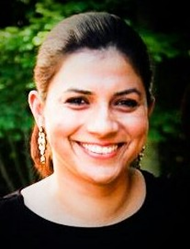
Manreet Kanwar, MD, is an AHN cardiologist who specializes in heart failure; she is also a board member of the International Society of Heart and Lung Transplantation.
“Based on our team’s leading expertise with LVAD technology, we were confident that with the proper pharmacological plan in place, paired with close monitoring, an LVAD could appropriately off-load her left ventricle, allow her heart to heal and put her heart failure into a form of remission.”
PITTSBURGH (PRWEB)
March 11, 2021
Cardiothoracic surgeons at Allegheny General Hospital (AGH), a part of Allegheny Health Network (AHN), are exploring a new indication for left ventricular assist devices (LVAD) as a bridge to recovery from heart failure after performing an explant procedure on a 21-year old patient from western Pennsylvania. The case has added to a growing recognition of the potential of LVADs beyond bridge to heart transplantation and is the focus of an article published by the AHN team in the Journal of Cardiac Failure (“Bridging the Gap to LVAD Recovery and Explantation” doi.org/10.1016/j.cardfail.2019.07.378).
Manreet Kanwar, MD, an AHN cardiologist who specializes in heart failure, and board member of the International Society of Heart and Lung Transplantation, is the lead author of the report.
Madysen Stauffer of Greensburg, Pennsylvania, was admitted to AGH in 2019 with severe nonischemic cardiomyopathy, a form of heart failure, likely caused by a viral infection. In such circumstances, an LVAD is often implanted to support a patient’s failing heart until a donor heart becomes available or to provide support on a permanent (“destination”) basis.
“Madysen’s profile as an otherwise healthy, young adult allowed us to really challenge the typical course of treatment. Although heart transplantation is an excellent option for many patients with end-stage heart failure, transplanted hearts generally last about 15 years, on average. Throughout the course of her lifetime, she could require up to three hearts,” explained Dr. Kanwar. “Based on our team’s long experience and leading expertise with LVAD technology, we were confident that with the proper pharmacological plan in place, paired with close monitoring, an LVAD could appropriately off-load her left ventricle, allow her heart to heal itself and put her heart failure into a form of remission.”
LVADs connect directly to the heart’s left ventricle and aorta to augment the organ’s natural pumping capacity. The LVAD doesn’t replace the heart, but rather helps it to pump blood from the heart to the aorta, restoring oxygenated blood flow to normal levels throughout the body.
In a 2020 study published in Circulation, (“Prospective Multicenter Study of Myocardial Recovery Using Left Ventricular Assist Devices” doi.org/10.1161/CIRCULATIONAHA.120.046415), heart specialists from across the country released results from a prospective, non-randomized study pulling from six health systems.
Forty patients with chronic advanced heart failure from nonischemic cardiomyopathy who received LVADs were enrolled, and of the population, 40 percent achieved sufficient myocardial function to reach criteria for explantation within 18 months with sustained remission from heart failure at 12 months. Overall, 19 patients were explanted based on myocardial improvement; survival – free from LVAD or transplantation –was 90 percent at one year and 77 percent at two and three years.
In a related review published in the Annals of Thoracic Surgery (“Bridge to Removal: A Paradigm Shift for Left Ventricular Assist Device Therapy,” doi: 10.1016/j.athoracsur.2014.07.061) researchers reviewed the trajectory of 81 LVAD patients and found that nearly 20 percent had significant recovery of left ventricular function within six months of implantation. It is one of the largest studies to prospectively link mechanical unloading with functional recovery.
In November 2019, Dr. Kanwar and a surgical team at AGH led by Masaki Tsukashita, MD successfully explanted Madysen’s LVAD, based on predetermined indications that the heart was deemed strong enough to function independently. Madysen is now a full-time electrical engineering student in her third year at Penn State; her heart continues to improve as she follows a strict medicine regimen each morning.
“I had an echocardiogram in February as part of a full panel of testing needed to get back into the classroom. My heart had shown no enlargement or significant change since my last imaging nine months prior, so it has since stabilized,” said Stauffer. “It’s been an amazing feeling to go back to school and gain back my sense of independence. My relationship with Dr. Kanwar has been one of the best I’ve ever had with a clinician and I can’t thank her and the AGH team enough. It’s great to know that I still have my heart and in its own way, it’s healing itself.”
Within, “Bridging the Gap to LVAD Recovery and Explantation,” Dr. Kanwar identifies 16 additional patients who received an LVAD at AGH from 2006 through 2017 who may have benefitted from a similar course of treatment based on their profiles.
“This case study is among the few successful LVAD explantation procedures documented in the country,” said Dr. Kanwar. “We believe it will further advance and challenge the standards of care for younger patients with end-stage heart failure and provide a viable alternative to cardiac transplantation in some cases.”
For more information on AHN and the AHN Cardiovascular Institute, visit ahn.org.
###
About the Allegheny Health Network:
Allegheny Health Network (AHN.org), a Highmark Health company, is an integrated healthcare delivery system serving the greater Western Pennsylvania region. The Network is composed of 13 hospitals, ambulatory surgery centers, Health + Wellness Pavilions, an employed physician organization, home and community-based health services, a research institute, and a group purchasing organization. The Network provides patients with access to a complete spectrum of advanced medical services, including nationally recognized programs for primary and emergency care, trauma care, cardiovascular disease, organ transplantation, cancer care, orthopedic surgery, neurology and neurosurgery, women’s health, diabetes, autoimmune disease and more. AHN employs approximately 21,000 people, has more than 2,500 physicians on its medical staff and serves as a clinical campus for Drexel University College of Medicine and the Lake Erie College of Osteopathic Medicine.
Share article on social media or email:

